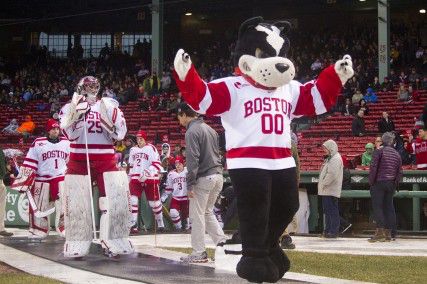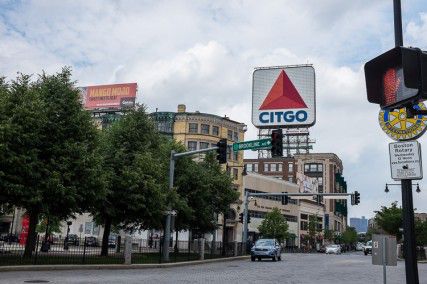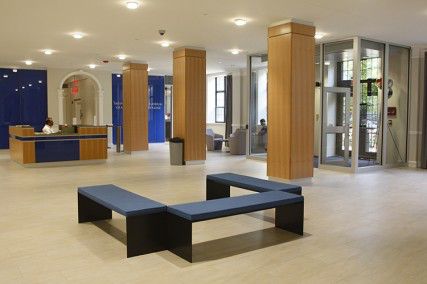
April 24, 1839
A group of Boston Methodist ministers establishes a theological school in Newbury, Vt., called the Newbury Biblical Institute, which would later become the BU School of Theology.
1847
The Congregational Society in Concord, N.H., invites the Institute to relocate to Concord. One stipulation of the invitation, however, was that the Institute remain in Concord for at least 20 years. The charter is issued by New Hampshire and designates the school the Methodist General Biblical Institute, but commonly called the Concord Biblical Institute.
1867
Trustees of the Concord Biblical Society purchase 30 acres of land in Brookline and move the Institute to 23 Pinckney St. in Boston, where it receives a Massachusetts Charter as the Boston Theological Seminary.
BU becomes the first American university to open all its divisions to women.
1869
Three Trustees of the Boston Theological Institute – Isaac Rich, Lee Claflin, and Jacob Sleeper, for whom the three West Campus dormitories are named – receive a charter from the Massachusetts Legislature to establish Boston University. The charter includes that no student or instructor at the university will be required to adhere to a certain religion, which was unprecedented at the time.
1871
BU absorbs the Boston Theological Seminary, creating the School of Theology, the first school at the university.
1872
BU establishes the School of Music, the first music school in the United States to grant degrees. The music school later became a division in the College of Fine Arts.
The Great Boston Fire of 1872, Boston’s largest urban fire, breaks out downtown on Summer Street before spreading to over 700 other buildings. In the aftermath of the blaze, several major city streets were widened, including Congress Street, Federal Street and Hawley Street. The rubble left by the fire was largely used to fill in Atlantic Avenue. The fire destroyed nearly all the buildings on BU’s campus, leaving the campus facilities scattered.
1873
The College of Arts and Sciences is established, under the name of the College of Liberal Arts. In the same year, Alexander Graham Bell gives the inaugural lecture for the School of Oratory. Bell, who was a professor at BU, created the telephone while he was part of the BU faculty.
William Fairfield Warren becomes the first president of BU.
BU becomes the first university to admit women to its medical school.
1877
BU becomes the first university in the United States to award a Ph.D. to a woman when Helen Magill White earns her doctorate degree in Greek. Emanuel Hewlett also graduates from the BU School of Law, becoming the first black law school graduate at BU and one of the first in the country.
1913
The College of Business Administration, later renamed the School of Management, opens its doors, allowing students to study a range of subjects from accounting and finance to marketing and entrepreneurship.
1917
Students begin considering the terrier the pride of BU, five years before the animal is officially chosen over the moose as the university’s mascot. The Boston Terrier was first bred in 1869, the year BU was chartered.

1918
Dr. Arthur H. Wilde founds the School of Education to teach the next generation of educators, make use of their talents and advocate for research that will contribute to the field of education.
1922
The Boston Terrier becomes BU’s official mascot. The iconic canine is named for the leading male character in Margaret Mitchell’s 1936 novel Gone with the Wind because “no one loves Scarlett more than Rhett,” referencing BU’s mascot and school colors.
1928
BU acquires Sargent College. Originally founded by Dr. Dudley Allen Sargent as the Sargent School of Physical Training in 1881, the college remained privately owned until becoming a part of BU, at which point it was renamed the College of Health and Rehabilitation Sciences: Sargent College.
1930
Scarlet and white become the official university colors. From the BU red acceptance letter and admissions folders to sports jerseys and graduation robes, scarlet and white are part of what it means to be a Terrier.
1938
Charles River Campus opens. A 15-acre purchase in 1920 along Commonwealth Avenue and the Charles River for $1.7 million unites all of BU’s colleges and schools on one campus.
1940
The School of Social Work is created. Originally a graduate program within the School of Religious Education and Social Service, the school went on to offer master’s and doctorate degrees to aspiring social workers seeking to improve urban life.
An early version of the famous CITGO sign is built. The iconic sign in Kenmore Square began as the marker

for Cities Services oil and gas before the company changed its name to CITGO Petroleum Company and redesigned the sign in 1965.
1947
BU becomes the first to offer a degree in public relations at its newly established School of Public Relations and Communications that would eventually become the College of Communication.
1948
Harry Agganis enrolls at BU. Starting as a quarterback on BU’s football team, Agganis set several school records and was named BU’s first All-American player before going on to serve in the Marine Corps and play for the Boston Red Sox for two seasons.
1950
The College of Industrial Technology, renamed the College of Engineering in 1963, is established as a result of the New England Aircraft School’s move to BU.
WBUR-FM debuts. Originally an educational station belonging to BU, WBUR grew in success, eventually becoming its own station and winning prestigious awards, such as the Associated Press and George Foster Peabody Awards.
1952
The College of General Studies is founded.
1953
The African Research and Studies Program, then called the African Studies Program, is created.

1954
The College of Fine Arts was founded.
1955
Martin Luther King, Jr. receives his Ph. D. in systematic theology.
1958
“The Most Interesting Man in the World,” Jonathan Goldsmith, graduates from the College of General Studies.
1963
The George Sherman Union opens.
1965
Warren Towers at 700 Commonwealth Ave. begins to be built.
1966
Before Harold Case retired as president from BU, he expanded the campus to about 45 acres and added approximately 68 buildings.
1970
Nationwide Vietnam War protests lead to the canceling of final exams and commencement, as well as dorm closures.
In May, two publications merge to become the Daily Free Press as colleges and universities are shutting down across the nation in response to the Kent State Shootings.
1971
John Silber becomes president of BU.
BU’s Men’s Hockey team is triumphant in the NCAA Championships for the first time.
1976
Radio personality Howard Stern graduates from the College of Communication.
1979
Actress and civil rights activist Geena Davis graduates from the College of Fine Arts.
1980
BU graduates and former players on the men’s hockey team, Jack O’Callahan, Jim Craig, Mike Eruzione and Dave Silk, help bring the United States to victory in the 1980 Winter Olympics, an event that was later depicted in the film “Miracle on Ice.”
1981
The School of Hospitality Administration is founded.
1997
BU discontinues its football team to adapt to financial and practical changes after the 1997 season.
2000
The BU men’s hockey team wins the Beanpot tournament for a record sixth year in a row. The Beanpot is an annual hockey tournament between the big four schools in the Boston area: BU, Northeastern University, Boston College and Harvard University. This record set by BU 14 years ago still stands today.
Student Village I opens to juniors and seniors at 10 Buick Street.
2002
The Elie Wiesel Center for Judaic Studies is opened. This center is a division of the College of Arts and Sciences that focuses on the study and research of Jewish history, culture and religion. Students at BU can now take general education classes as electives or pursue a minor in Jewish Studies through the center.
2005
A number of new buildings open at BU, including Agganis Arena, the Fitness and Recreation Center, The Florence and Chafetz Hillel House and the Life Science and Engineering Building.
2006
Former U.S. President George W. Bush appoints BU President Dr. Robert A. Brown to the President’s Council of Advisors on Science and Technology. Brown served on this council from 2006 to 2008.
2007
BU’s endowment reaches $1 billion for the first time.
Virginia Sapiro was appointed as the first female dean of the College of Arts and Sciences in its 141-year history.
2008
Construction of the $200 million National Emerging Infectious Disease Laboratories facility is completed, but controversy and litigation have prevented much of the building from fully operating. The lab is part of a national network of secure facilities dedicated to the development of diagnostics, vaccines and treatments to combat emerging and reemerging infectious diseases.
2009
BU’s first geothermal building opens at 888 Commonwealth Ave., home of BU’s International Education Center. The building’s energy is generated below ground by six wells. The building is cooled and heated entirely without the use of fossil fuels.
Student Village II, a 26 story dormitory opens at 33 Harry Agganis Way.
2010
Three hundred members of the Class of 1970 attended the 2010 commencement weekend. In 1970, BU was unable to hold a commencement ceremony because the United States was experiencing a period of national turmoil and campus wide anti-war protests. Members of the Class of 1970 were honored in a special service of remembrance.
2011

BU receives a $25 million gift from Rajen Kilachand (GSM ’74). The donation goes toward the University Honors College, later renamed the Arvind and Chandan Nandlal Kilachand Honors College.
2014
BU’s first class of Kilachand Honors College students graduate.
August 30, 2014
The Class of 2018 moves in and begins to make their own history at BU!
Correction: An earlier version of this story reported John Silber became president of the university in 1979.

















































































































